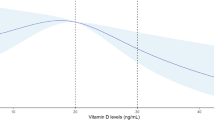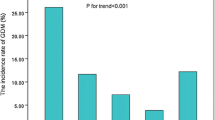Abstract
The progressive increase of insulin resistance observed in pregnancy contributes to the pathophysiology of gestational diabetes mellitus (GDM). There is controversy whether vitamin D deficiency contributes to abnormal glycemic regulation in pregnancy. We tested the associations between first trimester 25-hydroxyvitamin D (25OHD) levels and: 1) the risk of developing GDM; 2) insulin resistance/sensitivity, beta cell function and compensation indices in a large population-based prospective cohort of pregnant women. Participants (n = 655) were seen at first (6–13 weeks) and second (24–28 weeks) trimesters for blood samples. At first trimester, 25OHD levels were measured. At second trimester, glucose and insulin were measured 3 times during the oral glucose tolerance test to estimate insulin resistance (HOMA-IR), beta cell function (HOMA-B), insulin sensitivity (Matsuda index), insulin secretion (AUCins/gluc) and beta cell compensation (ISSI-2). Based on IADPSG criteria, 54 participants (8.2 %) developed GDM. Lower first trimester 25OHD levels were associated with higher risk of developing GDM even after adjustment for vitamin D confounding factors and GDM risk factors (OR = 1.48 per decrease of one SD in 25OHD levels; P = 0.04). Lower first trimester 25OHD levels were associated with higher HOMA-IR (r = − 0.08; P = 0.03), lower Matsuda index (r = 0.13; P = 0.001) and lower ISSI-2 (r = 0.08; P = 0.04). After adjustment for confounders, we found no significant association with HOMA-B and AUCins/gluc. Our results suggest that low levels of 25OHD at first trimester are (1) an independent risk factor for developing GDM and (2) associated with insulin resistance at second trimester.
Similar content being viewed by others
References
Homko C, Sivan E, Chen X, Reece EA, Boden G (2001) Insulin secretion during and after pregnancy in patients with gestational diabetes mellitus. J Clin Endocrinol Metab 86:568–573
Evensen AE (2012) Update on gestational diabetes mellitus. Prim Care 39:83–94
HAPO Study Cooperative Research Group, Metzger BE, Lowe LP, Dyer AR, Trimble ER, Chaovarindr U, Coustan DR, Hadden DR, McCance DR, Hod M, McIntyre HD, Oats JJ, Persson B, Rogers MS, Sacks DA (2008) Hyperglycemia and adverse pregnancy outcomes. N Engl J Med 358:1991–2002
Pittas AG, Lau J, Hu FB, Dawson-Hughes B (2007) The role of vitamin D and calcium in type 2 diabetes. A systematic review and meta-analysis. J Clin Endocrinol Metab 92:2017–2029
Liu E, Meigs JB, Pittas AG, Economos CD, McKeown NM, Booth SL, Jacques PF (2010) Predicted 25-hydroxyvitamin D score and incident type 2 diabetes in the Framingham Offspring Study. Am J Clin Nutr 91:1627–1633
Pittas AG, Sun Q, Manson JE, Dawson-Hughes B, Hu FB (2010) Plasma 25-hydroxyvitamin D concentration and risk of incident type 2 diabetes in women. Diabetes Care 33:2021–2023
Gagnon C, Lu ZX, Magliano DJ, Dunstan DW, Shaw JE, Zimmet PZ, Sikaris K, Grantham N, Ebeling PR, Daly RM (2011) Serum 25-hydroxyvitamin D, calcium intake, and risk of type 2 diabetes after 5 years: results from a national, population-based prospective study (the Australian Diabetes, Obesity and Lifestyle study). Diabetes Care 34:1133–1138
Khan H, Kunutsor S, Franco OH, Chowdhury R (2013) Vitamin D, type 2 diabetes and other metabolic outcomes: a systematic review and meta-analysis of prospective studies. Proc Nutr Soc 72:89–97
Makgoba M, Nelson SM, Savvidou M, Messow CM, Nicolaides K, Sattar N (2011) First-trimester circulating 25-hydroxyvitamin D levels and development of gestational diabetes mellitus. Diabetes Care 34:1091–1093
Baker AM, Haeri S, Camargo CA Jr, Stuebe AM, Boggess KA (2012) First-trimester maternal vitamin D status and risk for gestational diabetes (GDM) a nested case-control study. Diabetes Metab Res Rev 28:164–168
Zhang C, Qiu C, Hu FB, David RM, van Dam RM, Bralley A, Williams MA (2008) Maternal plasma 25-hydroxyvitamin D concentrations and the risk for gestational diabetes mellitus. PLoS ONE 3:e3753
Parlea L, Bromberg IL, Feig DS, Vieth R, Merman E, Lipscombe LL (2012) Association between serum 25-hydroxyvitamin D in early pregnancy and risk of gestational diabetes mellitus. Diabet Med 29(7):e25–32
Poel YH, Hummel P, Lips P, Stam F, van der Ploeg T, Simsek S (2012) Vitamin D and gestational diabetes: a systematic review and meta-analysis. Eur J Intern Med 23:465–469
Christesen HT, Falkenberg T, Lamont RF, Jorgensen JS (2012) The impact of vitamin D on pregnancy: a systematic review. Acta Obstet Gynecol Scand 91:1357–1367
Aghajafari F, Nagulesapillai T, Ronksley PE, Tough SC, O’Beirne M, Rabi DM (2013) Association between maternal serum 25-hydroxyvitamin D level and pregnancy and neonatal outcomes: systematic review and meta-analysis of observational studies. BMJ 346:f1169
Canadian Diabetes Association (2008) Can J Diabetes 2012:201
Anonymous (2004) Canadian Community Health Survey, Cycle 2.2. Nutrition (2004) A guide to accessing and interpreting the data. 2012
Lacroix M, Battista MC, Doyon M, Menard J, Ardilouze JL, Perron P, Hivert MF (2013) Lower adiponectin levels at first trimester of pregnancy are associated with increased insulin resistance and higher risk of developing gestational diabetes mellitus. Diabetes Care 36:1577–1583
International Association of Diabetes and Pregnancy Study Groups Consensus Panel, Metzger BE, Gabbe SG, Persson B, Buchanan TA, Catalano PA, Damm P, Dyer AR, Leiva A, Hod M, Kitzmiler JL, Lowe LP, McIntyre HD, Oats JJ, Omori Y, Schmidt MI (2010) International association of diabetes and pregnancy study groups recommendations on the diagnosis and classification of hyperglycemia in pregnancy. Diabetes Care 33:676–682
Aronov PA, Hall LM, Dettmer K, Stephensen CB, Hammock BD (2008) Metabolic profiling of major vitamin D metabolites using Diels-Alder derivatization and ultra-performance liquid chromatography-tandem mass spectrometry. Anal Bioanal Chem 391:1917–1930
Holick MF, Binkley NC, Bischoff-Ferrari HA, Gordon CM, Hanley DA, Heaney RP, Murad MH, Weaver CM, Endocrine Society (2011) Evaluation, treatment, and prevention of vitamin D deficiency: an Endocrine Society clinical practice guideline. J Clin Endocrinol Metab 96:1911–1930
Gagnon C, Baillargeon JP, Desmarais G, Fink GD (2010) Prevalence and predictors of vitamin D insufficiency in women of reproductive age living in northern latitude. Eur J Endocrinol 163:819–824
Matthews DR, Hosker JP, Rudenski AS, Naylor BA, Treacher DF, Turner RC (1985) Homeostasis model assessment: insulin resistance and beta-cell function from fasting plasma glucose and insulin concentrations in man. Diabetologia 28:412–419
Wallace TM, Levy JC, Matthews DR (2004) Use and abuse of HOMA modeling. Diabetes Care 27:1487–1495
Matsuda M, DeFronzo RA (1999) Insulin sensitivity indices obtained from oral glucose tolerance testing: comparison with the euglycemic insulin clamp. Diabetes Care 22:1462–1470
Retnakaran R, Shen S, Hanley AJ, Vuksan V, Hamilton JK, Zinman B (2008) Hyperbolic relationship between insulin secretion and sensitivity on oral glucose tolerance test. Obesity (Silver Spring) 16:1901–1907
Retnakaran R, Qi Y, Goran MI, Hamilton JK (2009) Evaluation of proposed oral disposition index measures in relation to the actual disposition index. Diabet Med 26:1198–1203
Zhao G, Ford ES, Li C (2010) Associations of serum concentrations of 25-hydroxyvitamin D and parathyroid hormone with surrogate markers of insulin resistance among US adults without physician-diagnosed diabetes: NHANES, 2003–2006. Diabetes Care 33:344–347
McLeod DS, Warner JV, Henman M, Cowley D, Gibbons K, McIntyre HD, for the HAPO Study Cooperative Research Group (2012) Associations of serum vitamin D concentrations with obstetric glucose metabolism in a subset of the Hyperglycemia and Adverse Pregnancy Outcome (HAPO) study cohort. Diabet Med 29(8):e199–204
Clifton-Bligh RJ, McElduff P, McElduff A (2008) Maternal vitamin D deficiency, ethnicity and gestational diabetes. Diabet Med 25:678–684
Talaei A, Mohamadi M, Adgi Z (2013) The effect of vitamin D on insulin resistance in patients with type 2 diabetes. Diabet Metab Syndr 5(1):8
Belenchia AM, Tosh AK, Hillman LS, Peterson CA (2013) Correcting vitamin D insufficiency improves insulin sensitivity in obese adolescents: a randomized controlled trial. Am J Clin Nutr 97:774–781
Mitri J, Dawson-Hughes B, Hu FB, Pittas AG (2011) Effects of vitamin D and calcium supplementation on pancreatic beta cell function, insulin sensitivity, and glycemia in adults at high risk of diabetes: the Calcium and Vitamin D for Diabetes Mellitus (CaDDM) randomized controlled trial. Am J Clin Nutr 94:486–494
Nagpal J, Pande JN, Bhartia A (2009) A double-blind, randomized, placebo-controlled trial of the short-term effect of vitamin D3 supplementation on insulin sensitivity in apparently healthy, middle-aged, centrally obese men. Diabet Med 26:19–27
Soheilykhah S, Mojibian M, Moghadam MJ, Shojaoddiny-Ardekani A (2013) The effect of different doses of vitamin D supplementation on insulin resistance during pregnancy. Gynecol Endocrinol 29:396–399
Asemi Z, Samimi M, Tabassi Z, Shakeri H, Esmaillzadeh A (2013) Vitamin D supplementation affects serum high-sensitivity C-reactive protein, insulin resistance, and biomarkers of oxidative stress in pregnant women. J Nutr 143:1432–1438
Cekmez F, Aydemir G, Aydinoz S, Pirgon O, Genc FA, Tunc T, Sarici SU (2012) Low 25-hydroxyvitamin D level and adiponectin is associated with insulin sensitivity in large gestational age infants. Cytokine 59:156–158
Marcotorchino J, Gouranton E, Romier B, Tourniaire F, Astier J, Malezet C, Amiot MJ, Landrier JF (2012) Vitamin D reduces the inflammatory response and restores glucose uptake in adipocytes. Mol Nutr Food Res 56:1771–1782
Alkharfy KM, Al-Daghri NM, Yakout SM, Ahmed M (2013) Calcitriol attenuates weight-related systemic inflammation and ultrastructural changes in the liver in a rodent model. Basic Clin Pharmacol Toxicol 112:42–49
Alkharfy KM, Al-Daghri NM, Yakout SM, Hussain T, Mohammed AK, Krishnaswamy S (2013) Influence of vitamin D treatment on transcriptional regulation of insulin-sensitive genes. Metab Syndr Relat Disord 11:283–288
Kirwan JP, Huston-Presley L, Kalhan SC, Catalano PM (2001) Clinically useful estimates of insulin sensitivity during pregnancy: validation studies in women with normal glucose tolerance and gestational diabetes mellitus. Diabetes Care 24:1602–1607
Acknowledgments
The authors acknowledge the Blood Sampling in Pregnancy clinic at the Clinical Research Center Etienne-Le Bel (CRCEL) affiliated to the CHUS; the assistance of clinical research nurses (Maude Gérard, Georgette Proulx, Suzan Hayes, Marie-Josée Gosselin) and research assistants (Caroline Rousseau, Pascal Brassard) for recruiting women and obtaining their consent; the contribution of Denis Cyr and Guy Fink for performing 25OHD analyses; and the CHUS laboratory for performing 25OHD extractions and blood glucose, calcium, phosphorus and parathormone analyses. CRCEL is a Fonds de Recherche du Québec—Santé (FRQS) supported research center. The study was supported by a Fonds de Recherche du Québec—Santé (FRQ-S) Operating grant (MF Hivert) and by Diabète Québec (P Perron). MF Hivert was awarded a FRQ-S research scholar, a Canadian Diabetes Association’s Clinical Scientist Award, and the Maud Menten Award from the Institute of Genetics (IG)—Canadian Institute of Health Research (CIHR). M Lacroix was supported by Diabète Québec, Centre de recherche Mère-Enfant de l’Université de Sherbrooke and Foundation of Stars.
Conflict of interest
None.
Author information
Authors and Affiliations
Corresponding author
Additional information
Communicated by Massimo Porta.
Electronic supplementary material
Below is the link to the electronic supplementary material.
Rights and permissions
About this article
Cite this article
Lacroix, M., Battista, MC., Doyon, M. et al. Lower vitamin D levels at first trimester are associated with higher risk of developing gestational diabetes mellitus. Acta Diabetol 51, 609–616 (2014). https://doi.org/10.1007/s00592-014-0564-4
Received:
Accepted:
Published:
Issue Date:
DOI: https://doi.org/10.1007/s00592-014-0564-4




